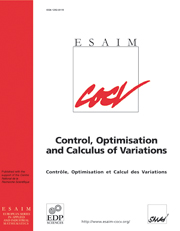Article contents
Unique continuation property near a corner and its fluid-structure controllability consequences
Published online by Cambridge University Press: 28 March 2008
Abstract
We study a non standard unique continuation property for the
biharmonic spectral problem $\Delta^2 w=-\lambda\Delta w$ in a 2D
corner with homogeneous Dirichlet boundary conditions and a
supplementary third order boundary condition on one side of the
corner. We prove that if the corner has an angle $0<\theta_0<2\pi$
in a 2D
corner with homogeneous Dirichlet boundary conditions and a
supplementary third order boundary condition on one side of the
corner. We prove that if the corner has an angle $0<\theta_0<2\pi$ ,
$\theta_0\not=\pi$
,
$\theta_0\not=\pi$ and $\theta_0\not=3\pi/2$
and $\theta_0\not=3\pi/2$ , a unique continuation
property holds. Approximate controllability of a 2-D linear
fluid-structure problem follows from this property, with a control
acting on the elastic side of a corner in a domain containing a
Stokes fluid. The proof of
the main result is based in a power series expansion of the
eigenfunctions near the corner, the resolution of a coupled infinite
set of finite dimensional linear systems, and a result of
Kozlov, Kondratiev and Mazya, concerning the absence of
strong zeros for the biharmonic operator [Math. USSR Izvestiya34 (1990) 337–353]. We also show how the same methodology
used here can be adapted to exclude domains with corners to have a local
version of the Schiffer property for the Laplace operator.
, a unique continuation
property holds. Approximate controllability of a 2-D linear
fluid-structure problem follows from this property, with a control
acting on the elastic side of a corner in a domain containing a
Stokes fluid. The proof of
the main result is based in a power series expansion of the
eigenfunctions near the corner, the resolution of a coupled infinite
set of finite dimensional linear systems, and a result of
Kozlov, Kondratiev and Mazya, concerning the absence of
strong zeros for the biharmonic operator [Math. USSR Izvestiya34 (1990) 337–353]. We also show how the same methodology
used here can be adapted to exclude domains with corners to have a local
version of the Schiffer property for the Laplace operator.
- Type
- Research Article
- Information
- ESAIM: Control, Optimisation and Calculus of Variations , Volume 15 , Issue 2 , April 2009 , pp. 279 - 294
- Copyright
- © EDP Sciences, SMAI, 2008
References
- 2
- Cited by




